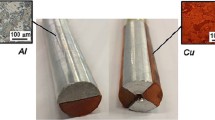Abstract
Components with large cross section differences and complex geometries are not or only hardly produceable using conventional hydroforming processes at room temperature. In order to overcome this difficulty, the combination with other forming processes is promising. In the present paper a process chain consisting of rotary swaging followed by a subsequent hydroforming is examined. Local material data such as flow stress and forming limits of the preform are characterized. Kinematic hardening is found out to be the predominant material behavior. Hence, appropriate control curves for hydroforming were designed via locally assigned material data in numerical simulations. A complex geometry is thus formed with the presented process chain. It is shown that high forming ratios of preformed areas are achievable when compressive stress is superimposed by axial feeding.










Similar content being viewed by others
References
Lang L et al (2004) Hydroforming highlights: sheet hydroforming and tube hydroforming. J Mater Process Technol 151(1–3):165–177
Ahmetoglu M, Altan T (2000) Tube hydroforming: state-of-the-art and fututre trends. J Mater Process Technol 98:25–33
Dohmann F, Hartl Ch (1996) Hydroforming - a method to manufacture light-weight parts. J Mater Process Technol 60:669–676
Groche P, Steinheimer R, Schmoeckel D (2003) Process stability in the tube hydroforming process. Ann CIRP 52(1):229–232
Groche P, Tibari K (2006) Fundamentals of Angular Joining by Means of Hydroforming. Ann CIRP 55(1):259–262
Merklein M, Geiger M, Celeghini M (2005) Combined tube and double sheet hydroforming for the manufacturing of complex parts. Ann CIRP 54(1):199–204
Imaninejad M, Subhash G, Loukus A (2005) Loading path optimization of tube hydroforming process. Int J Mach Tools Manuf 45(12–13):1504–1514
Aue-U-Lan Y, Ngaile G, Altan T (2004) Optimizing tube hydroforming using process simulation and experimental verification. J Mater Process Technol 146(1):137–143
Hartl Ch (2005) Research and advances in fundamentals and industrial applications of hydroforming. J Mater Process Technol 167(2–3):383–392
KocaŃDa A, SadŁOwska H (2008) Automotive component development by means of hydroforming. Arch Civ Mech Eng 8(3):55–72
Yuan SJ et al (2004) Hydroforming of typical hollow components. J Mater Process Technol 151(1–3):203–207
Mason MR, Klages GA (2002) Method for expansion forming of tubing. US Patent 6,397,449 B1, U.S. Patent and Trademark Office, Washington, DC
Vogler F, Bäcker F, Groche P (2010) Tailored Tubes and Blanks for Hydroforming. In: Liewald M (ed) Hydroumformung von Blechen, Rohren und Profilen, 6
Urban M et al (2006) Numerical research and optimisation of high pressure sheet metal forming of tailor rolled blanks. J Mater Process Technol 177(1–3):360–363
Trana K (2002) Finite element simulation of the tube hydroforming process—bending, preforming and hydroforming. J Mater Process Technol 127(3):401–408
Kim J, Kang BS, Hwang SM (2002) Preform design in hydroforming by the three-dimensional backward tracing scheme of the FEM. J Mater Process Technol 130–131:100–106
Groche P et al (2007) Incremental Bulk Metal Forming. Ann CIRP 56(2):635–656
Vogler F (2013) Beurteilung des Formänderungs-vermögens von Vorformen als Halbzeuge für das Innenhochdurckumformen. Darmstadt Shaker Verlag GmbH, Insitut für Produktionstechnik und Umformmaschinen
Lemaitre J, Chaboche JL (2002) Mechanics of solid materials. Press Syndicate of the University of Cambridge, Cambridge
Acknowledgments
The authors thank the European Research Association for Sheet Metal Working (EFB) and the German Federation of Industrial Research Associations „Otto von Guericke“ (AiF) as well as all participating companies for supporting the project.
Author information
Authors and Affiliations
Corresponding author
Rights and permissions
About this article
Cite this article
Groche, P., Vogler, F. & Wießner, L. Examination of tailored preforms produced by rotary swaging for subsequent hydroforming. Prod. Eng. Res. Devel. 9, 585–591 (2015). https://doi.org/10.1007/s11740-015-0633-8
Received:
Accepted:
Published:
Issue Date:
DOI: https://doi.org/10.1007/s11740-015-0633-8




